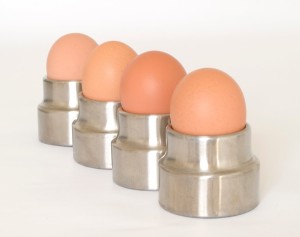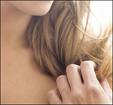
by theglamscientist | | Amino acids, cosmeceuticals, hair cycle, hair growth, health food, healthy hair, proteins |

I’m going to tell you ladies a secret… are you ready? Here it goes: One night while I was asleep, my son decided to rest his bottle in my hair. I woke up with a mane full of formula! I know what you’re thinking… “That is so gross!” “I hope you washed your hair immediately” The answers– “Not really all that gross.” “I washed my hair, eventually.”
Allow me to explain. My son suffers from multiple food allergies– milk and soy included. So instead of drinking the typical milk based formula, cow’s milk or soy milk, he drinks a hypoallergenic formula made solely of amino acids. It comes in powder form and I mix it with water. In essence, I had a fantastic conditioning treatment in my hair! Plus it’s tropical flavor, so it smells good too. If you’ll recall from your high school science classes, amino acids are the building blocks of proteins… and hair is made of a fibrous protein better known as keratin. Put simply, amino acids are hair food.
Amino acids combine to form proteins that will strengthen the hair and possibly help promote hair growth. Keep in mind, everyone’s hair growth cycle is different. You can’t grow waist length hair if that’s not in your DNA. See previous post Long, Luxurious Hair: The Science. Fortunately, you don’t have to have a formula incident to reap the benefits of amino acids and/or proteins. The claim to fame for those mayonnaise and egg kitchen conditioning treatments is the fact that they are rich in proteins, thus also rich in amino acids.
These days, cosmeceuticals are growing in popularity. They are no more than a collection of vitamins, minerals, etc that can be taken in pill form or have been packed into special beauty drinks. I’m all for cosmeceuticals– anything to keep it pretty. Just remember that you can add the same vitamins, minerals, essential fatty acids, etc to your diet just by incorporating the right foods. Amino acids are included in the list of beauty must haves that you can get find in your foods. Out of 22 amino acids, our bodies can produce 13. The remaining 9 need to be supplemented and are referred to as essential amino acids. Foods such as milk and meat contain all 9 essential amino acids. Remember the tagline for milk? “–it does a body good.” Add to that “–it gives you strong, healthy, pretty hair.” What woman doesn’t want great hair?! Other foods that contain essential amino acids are nuts, beans, soy, peas, rice, wheat and other grains. Alone these sources don’t contain all the essential amino acids, but combined you will get all that you need.
The next time you’re in the beauty supply, you can be confident in picking up products with amino acids listed in the ingredients. Until then, make sure your diet is giving you all the beauty food you need.
Here’s to the Glam Life!
by theglamscientist | | hair care, hair cycle, hair growth |

In order to maximize your personal hair growth cycle, you should implement a consistent hair care routine. This post is just my suggestion; the technique I use to ensure my hair is as healthy as possible. Remember healthy hair is key to getting your hair to its longest length. Alter this technique so that it suits your particular needs.
Wash your hair often (at least once a week) with a good quality moisturizing shampoo followed by moisturizing conditioner. Remember to steer clear of alcohols which are very drying to the scalp and hair. Greasy hair needs to be washed more often than dryer, curly hair. **Dirty hair does not grow faster than clean hair. That’s just nasty! Avoid 2 in 1 products; their conditioning is rarely as effective as a stand alone conditioner. For softer hair, do not rinse away all the conditioner. Leaving a trace of conditioner on the hair helps to smooth the cuticle layer and provides a layer of protection until the next wash. Once a month, I recommend a deep conditioner. Leave it on for no less than 10-15 minutes, but really what’s the rush? Relax, watch a movie, read a book.
As previously discussed, regular trims are essential to ensure the hair on your hair is its healthiest. I usually get my ends trimmed with every relaxer treatment. For me that is every 4 weeks. Most stylists recommend a trim every six to eight weeks. Just be mindful of how your ends look. If they are frizzy, dry or transparent, its definitely time for a trim.
Since heat is not a friend to our hair, keep heat styling to a minimum. Blow dry your hair and then heat style as desired ONCE A WEEK. Use a light hair oil or a thermal styling product to help protect your hair from heat damage. Do not pick up a flat iron, curling iron, crimping iron, etc again until the next wash. You’ll be surprised how much you reduce split ends and breakage just following this one rule.
There is a lot of pressure to go natural these days. If you feel the urge, look for products with botanicals, herbs and minerals in the ingredients. Such products will provide many nutrients that the body does not produce on its own. You can get the same benefits of natural hair care by altering your diet to include the foods discussed in “The Friend”. When making the switch from mainstream hair products to all natural hair products, the condition of your hair may appear to get worse before it gets better. This phenomenon is similar to an addict in recovery, the hair goes through a withdrawal period.
One last note, chemically treated hair needs extra TLC. If your hair is permanently colored, bleached, permed or relaxed, you should consider using a deep conditioner with each wash and adding a hot oil treatment once a month. You may also find that you need to get your ends trimmed more regularly. To one and all– go easy on the styling products. Product buildup is definitely “The Enemy”.
Here’s to the Glam Life and Long, Luxurious Hair!
by theglamscientist | | hair care, hair damage, hair growth, health food, humectant |
In the previous posts for the Long, Luxurious Hair Series, we discussed the science behind hair growth and factors that negatively affect the growth process. Armed with that information, we are now able to investigate ways to optimize individual hair growth cycles. The key is to protect the hair from extensive damage and breakage.
The very best way to promote healthy hair growth is from the inside out. Incorporating foods that aid in hair growth and strength is a healthy and safe way to reach the ultimate goal. Hair is made primarily of a strong protein called keratin which is also found in skin and nails. Variations in the amino acids found in keratin account for the differences in texture with some being soft and/flexible and some being hard. Since hair is made of protein, eating foods that are high in protein will be beneficial to the condition of the hair. Iron, B Vitamins, Essential Fatty Acids, Vitamin E and sulfur are also good additions to a healthy hair diet. Adding more of the following foods will be a good start: fish, eggs, leafy green vegetables, yogurt and nuts. Experimenting with different recipes that include these foods is a fun way to change your diet. Stear clear of hair growth supplements, they are potentially dangerous and unnecessary.
Aside from altering your eating habits, there are some topical hair treatments that will help to repair and prevent damage. Moisture is a must for healthy hair. Dry hair is often brittle and easily broken. It is important to note that hair oil products are not moisturizing products. Good moisturizing products will infuse moisture (water) in the hair shaft which hydrates the cuticle layer helping to create shine and prevent breakage and/or split ends. Use shampoos and conditioners that have humectants in the ingredients list. Humectants draw moisture to the hair and hold it there. Some humectants are glycerin, honey, sugar cane, hydrolyzed wheat starch, sodium PCA, panthenol, sorbitol, propylene glycol, butylene glycol and acetamide MEA. Also be sure to avoid of sulfates and alcohol which strip the hair of its natural oils.
Heat styling can cause damage to the hair shaft when used in excess. In addition to minimizing the use of heat, you should invest in thermal styling hair products which help to protect the hair from permanent damage and usually have other nutritive properties.
Finally, having your ends trimmed on a regular basis is your hair’s very best friend. Split ends are not only unsightly, but they spread. Ragged ends easily get tangled with other strands of hair and cause breakage when the hair is combed or brushed. Uncontrolled split ends continue to split, higher and higher up the hair shaft causing frizzy, dry, damaged looking hair. When this sort of damage is finally addressed, the hair has to be cut much more than it would had it been dealt with early. Most stylists recommend a scheduled trim every six weeks.
In the final post of the series, we will discuss a technique to maintaining healthy hair for optimal hair growth.
by theglamscientist | | hair care, hair damage, hair growth, hair relaxer |

Before I begin discussing “The Enemy”, I’d like to give a brief and blunt recap of Part I. Simply put, a person’s hair will grow only to the length that their individual growth cycle allows. There is no product or technique that will extend your unique hair growth cycle. That being said, healthy hair should be the ultimate goal. The result of improperly cared for hair is breakage. Naturally breakage abbreviates the potential length of your hair. There are several culprits which negatively affect the hair growth cycle. Included are heat, chemicals and styling products. Here’s why:
The most key fact in understanding “The Enemy” is knowing that by the time the hair emerges from the scalp, it is no longer alive. Consider a fresh flower arrangement. Once the flowers are cut, they are no longer receiving a continual supply of the nutrients needed to survive. As the recipient of the flowers, we do all we can to keep the flowers in bloom for as long as possible. We clip the stems at just the right angle, put them in water, add plant food, prune the leaves, etc. Similarly, our hair needs just as much TLC.
Heat styling can be both beneficial and counter-productive. The benefits will be discussed in Part III. When heat is applied to the hair, it breaks the hydrogen bonds (water molecules) found on the cuticle layer. The cuticle layer is then opened and the hair is able to be reshaped and maintains this new shape upon cooling. When water, in liquid or steam form, is introduced, the hydrogen bonds reform and the hair returns to its natural state. Excessive use of heat causes severe damage to the cuticle layer which will eventually lose its ability to “bounce back”, thus breakage results.
The majority of American women have chemically altered their hair at some point. This includes permanent waves (perms/jerry curls), relaxers and permanent color treatments. Each involves the use of strong acids or bases which just aren’t pretty for anything dead or alive. I’m sure I don’t need to prove that, each of those treatments will cause chemical burns on the scalp if left on too long. Damage to the cuticle layer from these processes is inevitable. In the case of permanent color treatments, the product is meant to literally strip the cuticle layer until the desired color is acheived. Sounds painful!
Styling products are not such harsh villains, but they can cause significant damage nonetheless. Typically, mousse, styling/sculpting gel, holding spray, etc contain alcohol which can be very drying to the hair. Paired with the heat from a blow dryer, curling or flat iron, the hair shaft suffers a great deal of damage apparent by split ends and breakage.
Look for Part III where I will discuss how to fight the enemy yet still enjoy the styling we love.
by theglamscientist | | anagen, catagen, hair cycle, hair growth, telogen |

The Science is Part I of a 4 part series geared at dispelling the myths, providing the facts and suggesting techniques for optimal hair growth. The topics to be discussed later are The Enemy, The Friend and The Technique.
Fact or Fiction? Anybody can grow long hair with proper care. FICTION– Here’s why:
Each individual has a unique hair cycle which accounts for the length of their hair. A complete hair cycle consists of 3 phases: anagen, catagen and telogen. Anagen is the active growth phase of the hair cycle. The duration of the anagen phase is 3-7 years depending on the individual. In contrast, the rate of hair growth is generally the same for everyone. Hair usually grows at a rate of one centimeter a month; although there are factors that can affect the rate of growth ie season and health. The anagen phase is initiated in the follicle embedded deep in the scalp. Over time, the follicle gradually rises to the surface presenting the hair shaft.
The catagen phase is the rest period for the hair lasting approximately 2-4 weeks. During the catagen phase, the hair is no longer actively growing, however; the follicle is still moving towards the surface of the scalp. The follicle also begins to shrink in size marking its near demise.
The final phase of the hair cycle is the telogen phase. This is the period of time in which the follicle sheds mature hair. The shedding period lasts about 3-4 months. In the telogen phase, hair is either shed naturally or pulled out painlessly in the typical grooming process of shampooing, combing, brushing, etc. With the shedding of old hair, the follicle is ready to cultivate the growth of new hair; thus marking both the ending and beginning of the hair cycle. At any given time, 90% of hair on the scalp is in the anagen phase while the remaining 10% is in the telogen phase.
The anagen phase is the segment of the hair cycle that is responsible for length. Unfortunately the duration of an individual’s anagen phase is genetically determined. In other words, there is no way to alter the length of one’s anagen phase nor the natural length of one’s hair. Hormones play a significant role in the anagen phase and provide an explanation for the variances in hair growth between men and women. Androgen, the male hormone present in both males and females, has the greatest affect on hair growth and thickness. Oestrogen, the female hormone also present in both sexes, decrease the rate of hair growth, yet extend the growth period. In pregnancy, the oestrogen levels are much higher which is why hair tends to grow longer in those 9 months. Ultimately, the balance between androgen and oestrogen in individuals regulates hair growth.





